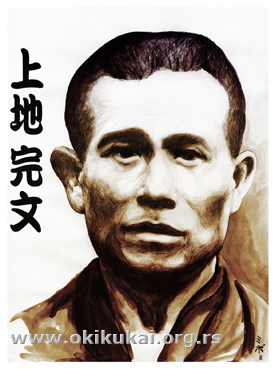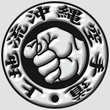• FOUNDERS / BIOGRAPHY
UECHI KANBUN

Uechi Kanbun was born in Izumi village on Okinawa in 1877. Together with his neighbor Matsuda Takasuburo he left Okinawa and went to the south China’s province Fukien in 1896. During the summer of the same year both of them enrolled in the Kojo Kaho's Martial Arts school where they were instructed by Master Makabe.
Few months later (at the end of 1896) Kanbun left KOJO school and in early 1897 met Master Shu Shi Wa who, at first, engaged him as an assistant for gathering sanative herbs. Later, he accepted Kanbun as his student. The circumstances under which Kanbun was accepted in the Martial Art school are still unknown. Anyhow, Shu Shi Wa began to teach him but in a very difficult and specific way. He taught Kanbun a form of Sanchin in the way of "one-by-one" technique, and he had to practice it faced to the wall for days and months. In that way SHU Shi Wa tested his persistence. Kanbun completed the Sanchin form after a year and then practiced only that form for another two years.
After three years of practicing, Kanbun visited his friend Takasaburo in the KOJO-DOJO. At that time he revealed that he had become a disciple of Master Shu Shi Wa. At insistence of his former instructor, Kanbun was demonstrated the SANCHIN form. Instructor Makabe was very surprised by evident Kanbun’s physical and mental progress.
Together with the form of SANCHIN, Uechi Kanbun was learned forms of SEISAN, SANSEIRYU, method of SEISAN-BUNKAI and techniques of the "IRON HANDS" and basic ideas of medicine and pharmacology. In spring of 1904 Shu Shi Wa promoted him to the title of "SIFU", but for another 3 years Kanbun stayed to practice.
On SHU Shi Wa insistence, at midsummer of 1906, UECHI Kanbun opened his own Dojo in northwest of Fukien province in Nanking (by area line away from Foochow about 200 kilometers).
Uechi Kanbun continued to keep contact with his sensei. Twice a year he traveled to Foochow to visit Shu Shi Wa and practice. There he met Go Ken Ki *), an expert in the ‘white crane” style. Later, Go Ken Ki very often visited Kambun's Dojo and practiced with him.
Kanbun’s Dojo in China was opened only for 3 years. At the end of 1909 he closed it and left Nanking. A year later (1910) he returned to Okinawa, settled at the estate of Motobu and soon married. He lived very quietly as a peasant and did not socialize with the locals. When his friend from China Go Ken Ki immigrated to Naha (1912), Kanbun started to pay him visits. Very soon Go Ken Ki became well-known on Okinawa as a good fighter. But, he always recommended Kanbun as a remarkable Master of Chinese 'Chuan-fa', which made Kanbun well-known primarily in Naha, and later all across Okinawa. However, Kanbun did not want to teach or demonstrate his skills. By some sources, Kanbun only once demonstrated his Seisan form at a festival in Shuri on insistence of a famous SHURI-TE Karate Master Itosu Ankoh at 1920.
At the begining of 1924 Uechi Kanbun left Okinawa and immigrated to the mainland Japan, to Wakayama-Town near Osaka. There he got a job in the cotton refinement factory "Shitaku". Employees Okinawans were familiar with Kanbun’s reputation and tried to persuade Kanbun to teach them. But as on Okinawa, Kanbun refused to teach and to socialize with others, until he met Tomoyose Ryuryu (also an Okinawan). Uechi Kanbun and Tomoyose Ryuryu became close friends, and in the middle of 1925, Ryuryu convinced Kanbun to start teaching him. Later he convinced him to accept some of Okinawans as students. That was how the first Kanbun sensei's Dojo was established in Japan (in June 1926).
The first Dojo of Kanbun sensei was located in the "SHITAKU" factory on Heiwa Street. Training sessions were kept secret, and only Okinawans who passed strict qualifications exams could enter the Dojo. The training system in the Dojo was strictly controlled. During the period of Shitaku Dojo period (1926-1932), apart from Tomoyose Ryuryu, were practised: Uehara Saburo, Akamine Kayei, Tamamura Susumu **), Kishimoto Kazuo, Sakiyama Shuei, Uchima Noburo, Yamashiro Kata & Kanbun’s oldest son Kanei.
In April 1932 the period of SHITAKU-DOJO came to an end. A new Dojo was opened in quart of Tebira. Kanbun named it: "PANGAI-NOON KARATE-JUTSU SHUBUKAI". Joining the Dojo became easier and members multiplied.
It enabled Kanbun sensei to leave job in factory and completely dedicate himself to teaching. Training sessions lasted for two to three hours every day and on Sundays and holidays even two times per day. During period of this the following students practiced: Tamagusuku Ryukichi, Ushiro Hachizo, Kishimoto Kazuo, Giba Takeo, Shimabuku Nacukichi, Uezato Gamnei,Takamine Kotoku, Shinjo Seiryu and Toyama Seiko.
In April 1937 Uechi Kanbun allowed his son Kanei to open a branch Dojo in Osaka.
Uechi Kanbun invented a ranking system in 1940. The only two students who were promoted by him were: Tomoyose Ryuryu and Kanei, his son. He promoted Tomoyose Ryuryu to the title of SHIHAN on 14th January 1940, and his son Kanei to same title on 14th Jan. 1941. Before Kanbun sensei returned to Okinawa, he promoted Tomoyose Ryuryu to the title of HANSHI. (Today, SHIHAN title can only be given to Masters of 5 Dan rank and above, and HANSHI title only to Masters of 9 DAN & 10 DAN).
Uechi Kanbun sensei was led the Dojo until Jan. 1946 when he handed it over to his student Tomoyose Ryuryu. He had made decision to return to Okinawa and most of his students came with him. On return to Okinawa they were sent to a camp on Ie-Jima island near the Okinawan northwest coast by the American occupation forces . In the camp Kanbun continued to run training sessions to keep the morale of his students. During that time Tomoyose Ryuko (today Honorary President of the OKIKUKAI association), a son of Ryuryu, also practiced there.
Uechi Kanbun died in 1948 at the age of 71 because of a hard life in the camp and starvation.
*) – Go Ken Ki was born in 1886 in Foochow, China, in family of a high social status. That enabled him to practice Martial Arts from his childhood. He left China and immigrated to Okinawa at 1912. In Naha-City he opened a store that sold herbs and teas. Very often he demonstrated his skills and accepted all challenges to fight. He died on Okinawa in 1940.
**) – Tamamura Susumu, one of the first students of Uechi Kanbun sensei, was the Supreme Adviser of the OKIKUKAI Association from the day of its foundation until his death, at the beginning of 2000.
| • • • |
